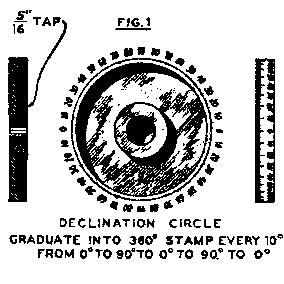
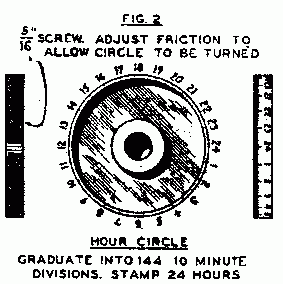
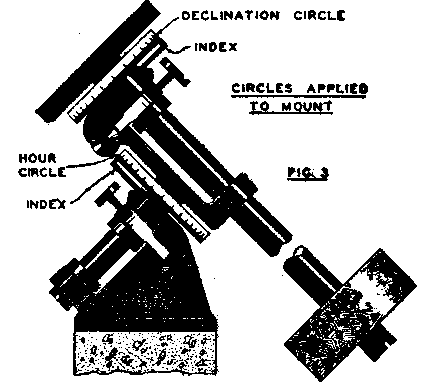
We will assume that you have completed your telescope and have seen the moon, Saturn, and random stars by its aid. You have found out for yourself the difficulty of picking up desired objects in the sky; and so you desire to apply circles to your equatorial mount (we assume that you have made one) so that you can point your instrument at the desired star, comet, planet or nebula, easily and accurately.
 |  |
 |
|
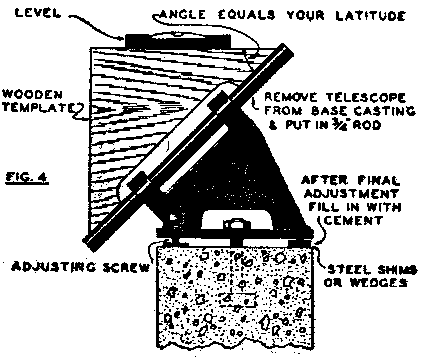 First we must adjust for latitude, by using a protractor and level, or a template and level as shown in Fig. 4. The angle between the horizontal and the polar axis should be equal to the observer's latitude; and adjustments are made either by slipping wedges under the base or by using the adjusting screws in the base until the level shows that this adjustment is correct. The telescope tube is then placed in a level position; and the declination circle is turned until the pointer is opposite the observer's latitude, and in this position it is permanently clamped.
First we must adjust for latitude, by using a protractor and level, or a template and level as shown in Fig. 4. The angle between the horizontal and the polar axis should be equal to the observer's latitude; and adjustments are made either by slipping wedges under the base or by using the adjusting screws in the base until the level shows that this adjustment is correct. The telescope tube is then placed in a level position; and the declination circle is turned until the pointer is opposite the observer's latitude, and in this position it is permanently clamped.
Next we must set the mount so that the polar axis points to the true north. This is easily done by selecting a time when the star Mizar, at the crook in the Dipper's handle, is directly over or under the Pole or North star, as shown in Fig. 5. The North Star, Polaris, is not at the exact celestial pole, but travels around it in a small circle. A line through Polaris and the true pole passes through Mizar, so if we wait until a plumb line shows these to be vertical, we know that they are directly north.
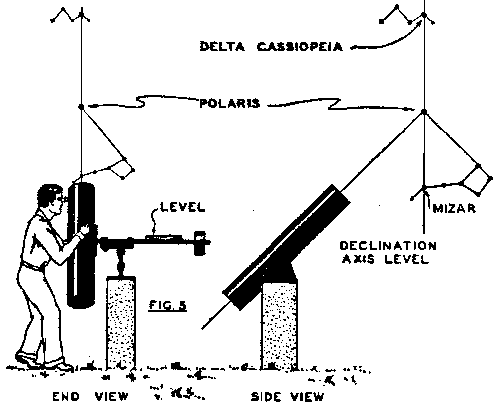 Set the declination axis of the telescope horizontal, using a level; and turn the instrument to either of these stars by turning the telescope on its declination axis, and the entire mount on the pedestal. Be sure the declination axis is level when the star is in the center of the field; and then tighten down the mount upon the pedestal permanently. The telescope is then in adjustment.
Set the declination axis of the telescope horizontal, using a level; and turn the instrument to either of these stars by turning the telescope on its declination axis, and the entire mount on the pedestal. Be sure the declination axis is level when the star is in the center of the field; and then tighten down the mount upon the pedestal permanently. The telescope is then in adjustment.
Instead of the fixed-type hour circle described in a former issue, we may decide upon a movable one which, by making its own computations, relieves us from figuring star or sidereal time; in fact from the use of a watch or other accessory. All we need is a star catalogue or chart giving the R.A.'s (Right Ascension) and declinations of the stars desired.
First turn the telescope on any convenient star, using the sights or the finder telescope, and bring the star into the center of the field. We will choose the first magnitude star Vega as being near and convenient. We loosen our hour circle and turn it, on the polar axis, until the pointer reads the R, A. to Vega, which is 18 hrs. 34 minutes. We clamp the circle in this position, first making sure that Vega is still in the center of the field. We have looked up the declination and R. A. of the Ring Nebula and have found them to be Decl. +32 degrees, and R. A. of 18 hrs. 51 min. We now swing the telescope in R. A. until the pointer reads 18 hrs. 51 min. and clamp it there; then swing it on the declination axis until the declination pointer reads + 32 degrees (+ means North of the celestial equator and - the South). On looking into the eyepiece of the telescope, we should see the smoke-ring-like image of this nebula.
This process may be applied to any heavenly object of which you have the declination and R. A. Simply set the telescope on a known object and adjust the hour circle: and then you can swing to any part of the sky to the R. A. and declination of the object desired. Don't waste time, however, for the stars keep moving, and your adjustment is correct only at the moment you make it. If you take more than minute or two in setting on a star sought, it will be gone. Should this happen (as it surely will until you become used to the adjusting) simply turn the telescope in R. A. towards the west, and you will at once overtake it. The declination does not change
 |
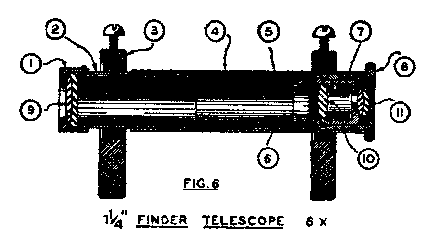 |
The finder telescope is best adjusted in the daytime by pointing the telescope at some prominent object, such as a distant church steeple or the gable of a house, and making sure that this object is in the center out of the field of view when observed through the eyepiece of the big telescope. Then the adjoining screws on the finder brackets are manipulated until this same object is centered on the cross-hairs of the finder.
If a star collides with another star, or even approaches near enough for the attraction to overcome the balance of forces in the star's interior, the star explodes, and throw off a shell of material which, in time, may become the hollow sphere of nebulous matter here observed. The parent star then settles down and becomes a very active central star that radiates the energy to excite the nebula into luminosity. Such explosions occur among the stars, and have been observed by astronomers.
If you will point your telescope to R. A. 19 hrs. 37 min., and Decl. + 27 degrees (first setting the hour circle on a known object), you will find that Alberio, the star at the foot of the Northern Cross. The telescope shows this to be a beautiful double star with components of different colors. It is one of the finest double stars in the sky. At R. A. 21 hrs. 29 min. and Decl. 2 degrees is an excellent globular cluster M-3 in Aquarius. Thousands of suns in a compact mass compose it. Another beautiful cluster is M-34 in Perseus, at R. A. 2 hrs. 36 min, Decl. +43 degrees. There is also a famous double cluster near by at R. A. 2 hrs. 15 min., Decl. +56 degrees.
(Note: Description of Saturn and Venus are dropped as they are dated to the 1933 era.) The moon, the favorite object for amateurs and their telescopes, is the nearest as well as the most striking of the celestial wonders. It is unique in the solar system for this reason: while other planets have moons, as does the earth, only the earth has a satellite so large in proportion to its own size. The moon's diameter is more than one-fourth that of the earth.
The moon's mountains, craters, valleys, seas and mysterious ray-systems offer too large a subject for this present article. We will leave it for the future and, in the meantime, the reader is advised to learn the principal features from the charts given in almost any of the elementary astronomy texts.
| R. A. | Decl. | ||
| Cluster M-15 in Pegasus (Globular Star) | 21 hr 25' | +12 | |
| Great Spiral Nebula in Andromeda | 0 hr. 36' | +41 | |
| Nebula in Cetus (very bright) | 0 hr. 42' | -26 | |
| Variable Star U in Cephus (mag. 7=9 period 35 hrs.) | 0 hr. 51' | +31 | |
| Double Star Gemma in Aries | 1 hr. 47' | +19 | |
| Gemma in Andromeda (beautiful triple star) | 1 hr. 57' | +42 | |
| Variable Star Omicron in Cetus (Mira)(mag. 2-10 period 332 days) | 2 hr. 13' | -4 | |
| Variable star Beta in Perseus (Agol)(Mag. 2-4 period 69 hrs.) | 3 hr. 0' | +40 | |
| Pleiades (open cluster with nebulous veil) | 3 hr. 40' | +23 | |
| Planetary Nebula H26 in Eridanus (with central star) | 4 hr. 10' | -13 | |
| Crab Nebula in Taurus | 5 hr. 28' | +21 | |
| Great Nebula in Orion | 5 hr. 29' | -5 | |
| Triple star Sigma in Orion (really four stars) | 5 hr. 33' | -3 | |
| Cluster M-35 in Gemini (very beautiful) | 6 hr 3' | +24 | |
| Double Star Alpha in Gemini (orange and blue stars) | 7 hr. 27' | +32 | |
| Cluster HVIII 35 in Argo (Puppis) | 7 hr. 31' | -14 |